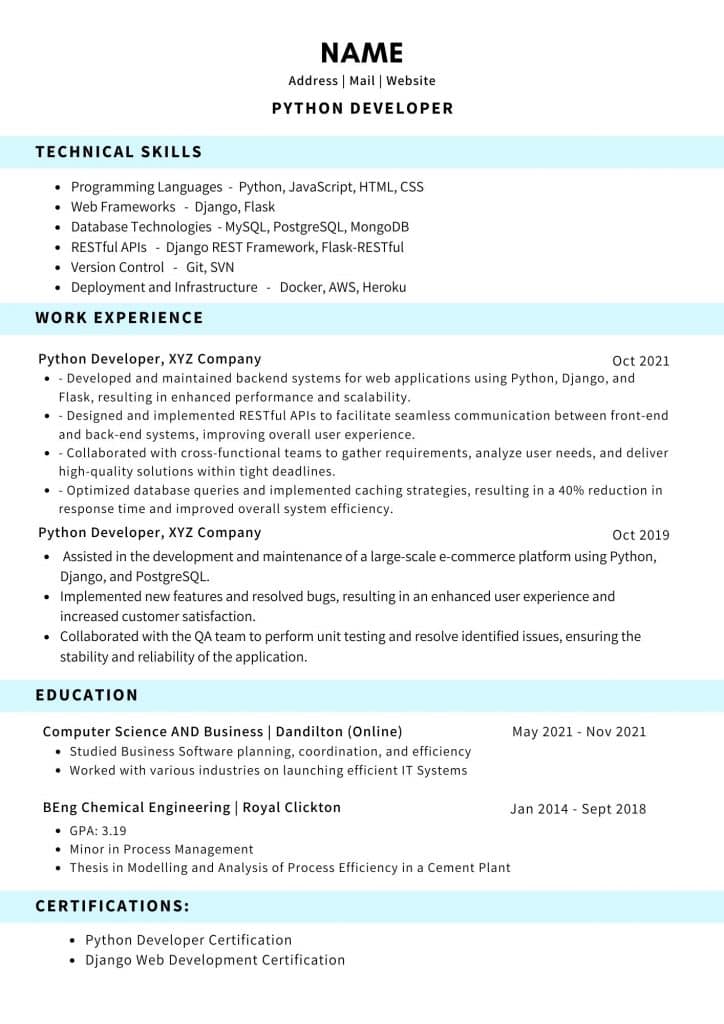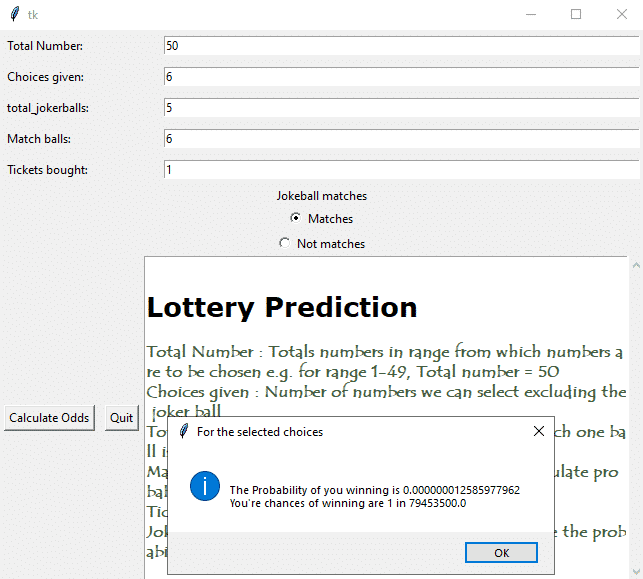Python developers are in high demand in today’s data-driven market. As per the most recent reports (until 2019) 42% of developers around the world use python due to its high flexibility, adaptability, and versatility. Python also happens to be one of the fastest-growing programming languages. Naturally, the number of jobs in Python is on the rise currently. Whether it is an entry-level Python job or a role that demands experience, Python roles are equally lucrative at both senior and junior levels.
As you embark on your journey to become a Python developer, your resume becomes the gateway to showcasing your expertise and landing your dream job. In this blog, we’ll guide you through the art of crafting a compelling Python developer resume, equipped with industry insights, sample resumes, and key factors that will help you stand out in a competitive job market.
- Python Developer Resume
- What are the skills required for Python developer?
- How do I write a resume for a Python developer?
- Resume Writing Guide of Python Developers
- Python Developer Resume Sample
- How do you write Python skills on a resume?
- Python Resume for freshers
- Python Projects for Resume
- How to learn Python?
- Further Reading
Python Developers write server-side web applications. S/he is responsible for developing, deploying, and debugging a project. Implementation of security, data protection, improving the functionality of existing applications, and coordinating various requirements are additional responsibilities of Python Developers.
Python Developer Resume
Companies are always on the lookout for great Python Developers. The skill requisites for each role depend on the hiring company, number of years of experience, and more such aspects. Before we jump into the key requirements on your Python Developer resume, let us understand the job description.
Experts in this domain need to have sound knowledge about Python. If you wish to learn more about the subject, you can take a look at this free Python course where you will learn the basics of Python and also get a certificate.
Before learning about the skills required, let us take a look at a few tips, to begin with.
- Use simple vocabulary and shorter sentences
- Try to ensure that your resume is readable and not cluttered with unnecessary information
- Make use of bullet points as opposed to paragraphs
- Ensure that all your skills, work experience, is covered in your resume. It is important to not skip any essential details
- Keep your resume clear and concise
- Check for grammatical errors before you submit your resume
- Proof-read your resume, and get it checked by friends or family members
What are the skills required for Python developer?
Most people frequently ask what are the mentionable skills for their Python Resume. Here’s how you should list skills on your resume:
- Core Python Expertise
- Knowledge of Web Frameworks
- Familiarity with Object Relational Mapper Libraries
- Required knowledge Artificial Intelligence and Machine Learning domains
- Fair knowledge of Deep Learning Fundamentals
- Good Understanding of Multi-Process Architecture. …
- Analytical and Problem-Solving Capabilities
- Expert-level Testing and Debugging skills
| Data Science Course Certificates |
| Data Science Course Placements |
| Data Science Course Syllabus |
| Data Science Course Eligibility |
Must-Have Skills for a Python Developer
- You must be familiar with Object Relational Mapper (ORM) libraries
- You need to know Python web frameworks such as Django or Flask
- S/he must be able to integrate multiple data sources and databases into a single system
- It is beneficial if you know server-side languages like Jinja 2, Mako, and more
- You should know front-end technologies such as JavaScript, HTML5, CSS3 is an added advantage
- Understanding fundamental design principles behind a scalable application
- Familiarity with event-driven programming in Python
- Must have unit testing and debugging skills
- Good problem solving and analytical skills
- Python packages such as NumPy, Scikit learn
How do I write a resume for a Python developer?
Once you are aware of the skills required, and you have acquired your bachelors or masters degree and are ready to join the workforce, the next step is to ensure that you have your resume.
Sections in a resume
- Header
- Personal Summary – Email address, phone number, GitHub profile, website (if applicable)
- Work Experience
- Projects you’ve worked on
- Educational Qualifications/ Certifications
- Skills
- Reference (if applicable)
Never downplay your achievements and success, your resume is the best place to showcase your skills as a Python Developer. There’s no need to fill every single part of your document, white space provides the recruiter with a visually appealing resume and could leave a good impression of you. You wouldn’t want your Python resume to look like you’ve learned your skills from a “learn Python in 24 hours” video, it is important to show the recruiter that you have adequate knowledge and have practised your skills.
Resume Writing Guide of Python Developers
According to the data from writrox, Recruiters spend around 5 to 7 seconds on average going over resumes. Quite an astonishing fact right? So, it is important to have an elegant and structured resume that stands out. Download our FREE Resume Writing Guide for Python Developers here
[wpforms id=”60493″ title=”false”]
Python Developer Resume Sample
Pro Tip: Don’t shy away from giving every detail regarding your work experience and achievements. Flaunt your achievements.
How do you write Python skills on a resume?
This question might cross your mind as soon as you sit down to write your resume. Let us take a look at a few tips to see how should you approach writing your resume.
- Add Python frameworks, project management skills, and tools within your resume
- Display the scale of work that you have done
- Showcase the quality of code you write
- It is important to customise your resume to the job you’re applying for
- If your resume is tailored to showcase other skills that may not be relevant to the job you are applying for, it’s best to remove such skills and highlight the ones related to Python
- If you have worked on research papers, published your open source projects, ensure to highlight these points
While creating your resume, you can choose between one of two resume formats. The two formats are-
- The reverse chronological order
- The functional layout
The reverse chronological layout showcases your work experience in the form of a timeline and might be the better option to opt for. A functional resume format focuses on your skills but doesn’t tell a story. Depending on the company you are applying for, you can choose the format more suitable for you.
Also Read: Machine Learning Resume: How to Build a story ML Resume
The best way to write your Python Developers Resume summary is to-
- Listing the total years of experience using Python
- Show what work you’ve done with Python (projects/ industry applications)
- Mention any special awards that you have received
- Open source project(s)
If you’re making a shift in career, a summary can prove to be quite impactful.
Example-
The right way to include your work experience in your resume is to-
- List all the projects you worked on during your current and past employment
- Which technology stack did you use (languages, frameworks, tools)
- Details regarding how you handled testing/continuous integration/devops
- List the scale of the projects (number of customers, requests per second, LOC, etc.)
- Weather you were responsible for the architecture and team management too
You can change the details in your resume depending on the job requirements such as database modeling and design, or whether it is slightly generic.
Python Resume for Freshers
If you are a fresher, you may not have too many things to showcase, especially in the area of work experience. In this case, you can aim to focus on your projects, certifications, internships, technical skills, and soft skills.
Pro Tip: You must edit and restructure your resume based on the job you are applying for. Accommodate job requirements in your skillset, achievements sections.
Research which company you will be applying for and what exactly their job requirements would look like. As a fresher, some of the skills you can include are as follows-
- Hands-on Python Development
- Problem-solving and reverse engineering skills
- List the Python Frameworks you have worked with
- Understanding of Databases and SQL
- Basics of TLC scripting
- Investigation of new processes, technologies, and tools
- Whether you can contribute to the development and design of app features
Python Resume Sample Template

Python Projects for Resume
There are various projects that can add value to your resume and here I am going to briefly describe one such project:
Lottery Calculator: Lotteries such as PowerBall and Lotto America have gained quite some attention and each year millions of people decide to participate in such lotteries without knowing their chances of winning it. In this project, we are going to make an application that can calculate your chances of winning the lottery given some of the lottery rules such as number of balls one can choose, number of total balls available in the game and so on.
def factorial(n):
fact=1
while(n>1):
fact=fact*n
n=n-1
return fact
def combinations(n,k):
num = factorial(n)
den = factorial(k) * factorial(n-k)
return num / den
def comb_ways(a,total_num,num_choices):
num=factorial(num_choices)*factorial(total_num-num_choices)
den=factorial(a)*factorial(num_choices-a)*factorial((total_num-num_choices)-(num_choices-a))*factorial(num_choices-a)
return num/den
def one_ticket_probability(total_num,tickets,num_choices,num_joker,match_num,joker_ball=False):
outcome_numbers=combinations(total_num, num_choices)
successful_outcome = tickets
if joker_ball==True:
outcome_jokerBall = num_joker
else :
outcome_jokerBall = (num_joker)/(num_joker-1)
total_outcomes = (outcome_numbers / comb_ways(match_num, total_num, num_choices)) * outcome_jokerBall
probability_winning = (successful_outcome / total_outcomes)
print("You're chances of winning are {:.18f}".format(probability_winning))
print("You're chances of winning are 1 in {}".format(
total_outcomes/successful_outcome))
return probability_winning, (total_outcomes / successful_outcome)
total_numbers=50#Range
number_choices=6 #Number of choices
total_jokerBalls=5 #Number of joker balls
match_numbers=6 #Countr of matched numbers
Joker_present=True #Presence of joker ball
tickets=1 #Total number of tickets bought
for match_numbers in range(match_numbers+1):
if(Joker_present):
print("Joker Ball matches-",end=" ")
else:
print("Joker Ball does not match-",end=" ")
print("Count of Numbers that matched the winning numbers = {}".format(match_numbers))
one_ticket_probability(total_numbers,tickets,number_choices,total_jokerBalls,match_numbers,Joker_present)
Now next step is to create a GUI through which the user can interact with the above program. All we need is some basic knowledge of the Tkinter module of Python to make it:
#First we define a new function that calculates
#the probabilities and also gives results in a message box
import tkinter as tk
from tkinter import messagebox
def Calculate(entries):
cal = one_ticket_probability(int(entries['Total Number'].get()),
int(entries['Tickets bought'].get()),
int(entries['Choices given'].get()),
int(entries['total_jokerballs'].get()),
int(entries['Match balls'].get()), v.get())
messagebox.showinfo(
"For the selected choices ",
"nYou're chances of winning are {:.18f} nYou're chances of winning are 1 in {}n"
.format(cal[0], cal[1]))
#We use tkinter to make a window object
root = tk.Tk()
#we make a form for user to give his values
def makeform(root, fields):
entries = {}
#These are default values for lotto-india
default_vals=['50','6','5','6','1']
for field in fields:
print(field)
row = tk.Frame(root)
lab = tk.Label(row, width=22, text=field + ": ", anchor='w')
ent = tk.Entry(row)
ent.insert(0,default_vals[fields.index(field)])
row.pack(side=tk.TOP, fill=tk.X, padx=5, pady=5)
lab.pack(side=tk.LEFT)
ent.pack(side=tk.RIGHT, expand=tk.YES, fill=tk.X)
entries[field] = ent
return entries
fields = [
'Total Number', 'Choices given', 'total_jokerballs', 'Match balls',
'Tickets bought'
]
ents = makeform(root, fields)
v = tk.IntVar()
tk.Label(root,
text="Jokeball matches",
justify=tk.CENTER,
padx=20).pack()
tk.Radiobutton(root, text="Matches", padx=20, variable=v,
value=True).pack(anchor=tk.CENTER)
tk.Radiobutton(root, text="Not matches", padx=20, variable=v,
value=False).pack(anchor=tk.CENTER)
b1 = tk.Button(root, text='Calculate Odds',
command=(lambda e=ents: Calculate(e)))
b1.pack(side=tk.LEFT, padx=5, pady=5)
b3 = tk.Button(root, text='Quit', command=root.quit)
b3.pack(side=tk.LEFT, padx=5, pady=5)
text2 = tk.Text(root, height=20, width=60)
scroll = tk.Scrollbar(root, command=text2.yview)
text2.configure(yscrollcommand=scroll.set)
text2.tag_configure('bold_italics', font=('Arial', 12, 'bold', 'italic'))
text2.tag_configure('big', font=('Verdana', 20, 'bold'))
text2.tag_configure('color',
foreground='#476042',
font=('Tempus Sans ITC', 12, 'bold'))
text2.insert(tk.END, 'nLottery Predictionn', 'big')
quote = """
Total Number : Totals numbers in range from which numbers are to be chosen e.g. for range 1-49, Total number = 50
Choices given : Number of numbers we can select excluding the joker ball
Total Jokerballs : Total number of jokerballs from which one ball is to be chosen
Match balls: For how many matches you want to calculate probability
Tickets : Number of Tickets bought
Jokerball matches : Keep True if you want to calculate the probability of jokerball matching too
"""
text2.insert(tk.END, quote, 'color')
text2.pack(side=tk.LEFT)
scroll.pack(side=tk.RIGHT, fill=tk.Y)
root.mainloop()
Output:

Learn more about Python
Key Factors for Landing Your Dream Job:
- Highlight Python Proficiency: Showcase your expertise in Python programming, highlighting specific libraries, frameworks, and tools you have worked with. Demonstrate your ability to write clean, efficient, and maintainable code.
- Showcase Web Development Skills: Emphasize your experience with web frameworks such as Django and Flask, along with your proficiency in frontend technologies like HTML, CSS, and JavaScript. Highlight your ability to develop RESTful APIs and integrate with databases.
- Demonstrate Problem-Solving Skills: Highlight your problem-solving abilities through examples of debugging, troubleshooting, and optimization. Showcase your experience in algorithm design and your approach to tackling complex technical
How to Learn Python?
One of the main reasons people would prefer to learn Python is its popularity and ease of learning. It is simpler to learn and is a type of free programming language. The time taken to learn this programming language would depend on which level you would want to achieve and depends on your learning ability.
Start learning Python from the very basics, such as the syntax, key-words, functions and classes, data types, basic coding, and exception handling. You are not required to have advanced programming knowledge, depending on the nature of your work, you can learn skills such as database programming, synchronisation techniques, multithreading, etc.
Also Read: Python Developer Salary in India
Higher-level Python skills include Data Analytics, hands-on experience of various Python libraries such as NumPy and Pandas, image processing, and more. To master these skills, you will require up to a few weeks to learn the basics and longer to implement and experiment with each.
The basic educational qualification to become a successful Python Developer would be a bachelors degree in Computer Science or any related field. A post-graduation and work experience will act as an added advantage.
You can read our blog on the top interview questions for Python. This will give you an idea of how much knowledge you have and what more to work on before going in for your dream job interview.
Before applying to any job, you must carefully plan and consider all aspects. Job roles in the field of Python are rapidly growing. Technical skills as well as soft skills are important to highlight in your resume, ensure that you cover all your skills. Including projects that you have worked on and codes you have performed increases your chances of being selected by the recruiter. If you wish to upskill and prepare further, you can enrol with Great Learning’s PG program in Artificial Intelligence and Machine Learning. Remember to showcase your Github profile or your website to showcase projects you have worked on. All the best for your journey with Python.
Employers value candidates who invest in their education. Consider exploring online courses with certificates to further bolster your expertise and impress potential employers.






